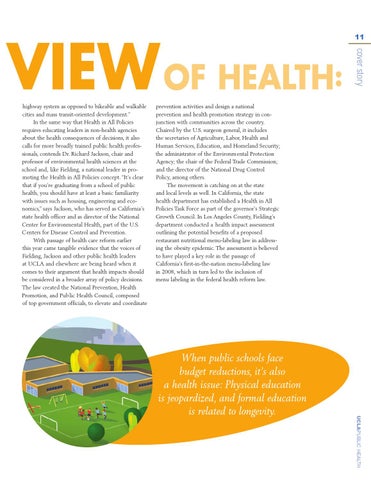SPH.nov10.toc-17_SPHmag.June04.2-19 3/3/11 3:29 PM Page 12
highway system as opposed to bikeable and walkable cities and mass transit-oriented development.” In the same way that Health in All Policies requires educating leaders in non-health agencies about the health consequences of decisions, it also calls for more broadly trained public health professionals, contends Dr. Richard Jackson, chair and professor of environmental health sciences at the school and, like Fielding, a national leader in promoting the Health in All Policies concept. “It’s clear that if you’re graduating from a school of public health, you should have at least a basic familiarity with issues such as housing, engineering and economics,” says Jackson, who has served as California’s state health officer and as director of the National Center for Environmental Health, part of the U.S. C enters for Disease Control and Prevention. With passage of health care reform earlier this year came tangible evidence that the voices of Fielding, Jackson and other public health leaders at UCLA and elsewhere are being heard when it comes to their argument that health impacts should be considered in a broader array of policy decisions. The law created the National Prevention, Health Promotion, and Pub lic Health Council, composed of top government officials, to elevate and coordinate
cover story
VIEW OF HEALTH:
11
prevention activities and design a national prevention and health promotion strategy in conjunction with communities across the country. Chaired by the U.S. surgeon general, it includes the secretaries of Agriculture, Labor, Health and Human Services, Education, and Homeland Security; the administrator of the Environm ental Protection Agency; the chair of the Federal Trade Commission; and the director of the National Drug Control Policy, among others. The movement is catching on at the state and local levels as well. In California, the state health department has established a Health in All Policies Task Force as part of the governor’s Strategic Growth Council. In Los Angeles County, Fielding’s department conducted a health impact assessment outlining the potential benefits of a proposed restaurant nutritional menu-labeling law in addressing the obesity epidemic. The assessment is believed to have played a key role in the passage of California’s first-in-the-nation menu-labeling law in 2008, which in turn led to the inclusion of menu labeling in the federal health reform law.
UCLAPUBLIC HEALTH
When public schools face budget reductions, it’s also a health issue: Physical education is jeopardized, and formal education is related to longevity.
